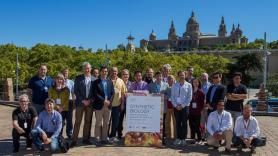3. Towards a world of applications
Although the line between synthetic biology and traditional genetic engineering is somewhat blurred, modifying the genome of microorganisms already has several different applications. For example, in 1978 scientists created a bacteria that produces insulin and the hormone taken by diabetics today comes from this genetically modified bacteria.
More recently, in 2013, the use of synthetic artemisinin, a malaria drug produced very effectively by modified yeasts, gained approval. In the future, scientists expect to see bacterial systems that, once introduced into our bodies, can take care of smart delivery of drugs like antibiotics and insulin right when we need them. “But they are highly complex systems that must have maximum security. We’re still far from that,” says García-Ojalvo. Other applications seem to be closer, like immunotherapy for cancer, designing new antibiotics or recycling plastics. Even the possibility of creating safer modified organisms that use synthetic amino acids not found in nature.
Searching for new antibiotics
The growing, improper, use of antibiotics is leading to an increase in the microorganisms that are resistant to them, and this is a growing threat. In the laboratory of Sven Panke, professor in the Department of Biosystems Science and Engineering at ETH Zurich, they use two promising antibiotics generated naturally by bacteria as a start. His team is testing modifications like the incorporation of artificial amino acids to give rise to new functions.
Recycling plastics
“Many industrial designs are made to last, so they won’t degrade,” explains Víctor de Lorenzo, professor in the Systems Biology Program at the Spanish National Center for Biotechnology in Madrid. “Bacteria haven’t yet had time to figure out how to do it.”
In his laboratory, they work with a specific type of bacteria, called Pseudomonas putida, that can break down certain types of plastic like that used in water bottles. But they aren’t very efficient and need to be improved. To do so, they try to organize them so they will join forces and work in teams: “It’s what we call bacterial origami,” he says. To do so, they get rid of part of their genome and add the information needed to produce new adhesins, molecular “stickers” at the disposal of researchers. They are even working to make the bacteria not only break down the plastic but also turn it into a new biodegradable compound that can be used.
Unknown functions in microorganisms
For Farren Isaacs, professor at Yale University, “we are moving from the era of reading genomes to that of writing them.” Even that of adding a new language. This scientist uses a technique known as MAGE, which allows him to introduce numerous changes into a genome at once, and then amplify them greatly, creating a huge list of new combinations. It is an “evolution machine” that speeds up natural processes so that in just a few days, for example, they made a bacteria produce huge amounts of lycopene, the red pigment found in tomatoes.
But it also allows them to introduce the necessary changes to make certain DNA sequences change their meaning. There are hundreds of possible amino acids, but nature only uses roughly 20 for life. Isaacs’ team has used that change in meaning to incorporate new amino acids never before used in a living being. They have literally expanded the genetic code. This could be used to create new functions, like microorganisms that produce new biopolymers, but also to improve safety: new organisms that die outside the laboratory, as nature doesn’t provide them with the amino acids they require.



